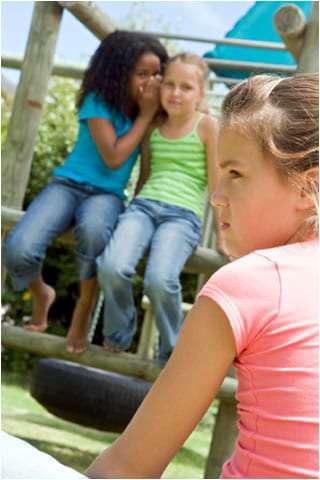Is Empathy the key to conquering bullying?
by Dr. Melinda Bossenmeyer, The Recess Doctor
As I observed my class the first week of school, one child stood out. The incident happened on the third day of school.
Allie was a kindergarten student who learned that another child’s much-loved dog died. Most students sat silently, observing the pain in another student’s face as the tears rolled down her cheeks as she shared her recent experience. Clearly feeling the emotions, Allie went over and hugged the other student saying, “Oh, Sarah you’re so sad.” It was the empathy in Allie’s comforting words that said it all. The shared experience; the common pain.
I was struck by the empathy of one 5 year old who was providing comfort to another. At the time, I wondered silently “How did Allie learn this? Has she lived through a lot of loss? Or is she simply a sensitive kid?”
In my study of bullying, I learned that Allie’s reaction is called empathy. In solving school bullying, teaching children empathy has proven to be a successful strategy.
In a Time magazine article on bullying called “How Not to Raise a Bully”, it stated, “Increasingly, neuroscientists, psychologists, and educators believe that bullying and other kinds of violence can indeed be reduced by encouraging empathy at an early age.“
Recent research in empathy — the ability to walk in another person’s shoes — has suggested that it is key to all human social interaction and morality. Without empathy, schools would be places where trust could not be developed and survival of the fittest would reign.
Contrary to earlier theories, we now know that empathy develops naturally over time and seems to be an innate skill set. However, children traumatized early in life or neglected, often don’t make the connection between people and pleasure, thus stunting their ability to be empathic. Children in loving environments on the other hand, with caring and discipline, show early signs of empathy.
“No school can be a great school unless students feel safe.”
Arnie Duncan U.S. Secretary of Education
The good news for schools is that “You can enhance empathy by the way you treat children,” says Martin Hoffman, an emeritus professor of psychology at New York University and a pioneer of empathy research, “or you can kill it by providing a harshly punitive environment.”
A positive school climate results in reasonable boundaries, consistent discipline and high expectations for student’s positive behavioral interactions. In short discipline, but
The Safe & Drug-Free Schools and Communities Act (SDFSCA) program is the Federal Government’s primary vehicle for reducing violence, alcohol and other drug use through supporting education, prevention and intervention activities in our Nation’s schools. Safe and Drug-Free Schools Department also oversees bullying prevention programs and grants.
A student must feel safe at school in order to thrive and learn. Feelings of personal safety have a direct positive impact on academics.
How do you know if a student lacks empathy?
- Poor at reading visual cues regarding emotion (happy, sad, angry, etc.)
- Difficulty “relating” to others
- Difficulty being supportive of others
- Difficulty understanding how others might “feel”.
Parents, teachers and caring adults can teach empathy. It requires that a child view others instead of a self-centered view of the world. Lessons that require students to write or talk about how another might be “feeling” when being bullied, or facing challenges, or when students are unkind; all require a view from outside oneself. Start by teaching students to first understand their own feelings and behavior, and then they will be more likely to understand the feelings and behavior of others.
Mary Gordon, Founder of Roots of Empathy, developed a school-based program to foster compassion. It resulted in reducing bullying. The program has a parent bringing a baby into the classroom with students observing and identifying what a child needs when he/she cries. “Students are taught that a crying baby isn’t a bad baby, but a baby with a problem. By trying to figure out what’s going on, the children learn to see the world through the infant’s eyes and understand what it might be like to have needs but not be able to express them clearly.”
The baby relies on outside assistance, which is one of the most successful strategies for elimination of bullying. Outside assistance at a school typically comes in the form of a
First, rarely will an adult witness bullying at school. Students do not bully victims in front of adults most of the time. So bullying occurs most often with “an audience” in front of peers, who are defined in bullying literature as bystanders.
Secondly, the effect of observing another child being bullied has a detrimental effect on the bystander. Bystanders who have not intervened report anxiety regarding the incident as they say, “I’m afraid I’ll be next. Or I don’t want any problems and I know that kid (bully is really mean).“
For those children who intervene, audience (bystander) disapproval has been shown to discourage bullying from continuing about 50% of the time. But the statistics on children intervening are about 1 in 5 or 20%. Yet another challenge in preventing bullying is the data that indicates approximately 25% of bystanders will actually encourage the bullying episode. An important skill for schools to teach students is “how to intervene” because 2/3 of elementary school bystanders say they know that they should.
The obvious intervention is to tell the bully to stop, but other options may be more effective. For example, telling a teacher. Schools can assist by explaining the difference between Tattling and Telling. One program, Peaceful Playgrounds has made an important distinction in the two activities, by clarifying the difference. If you are trying to get a peer out of trouble that is “telling”. If you are trying to get someone into trouble that is “tattling”. Bystanders who report bullying need to be taught that bullying is always a telling incident since they are helping the victim. Another option might be to distract the bully by saying “the teacher is looking for you”. Yet another might be to support the child being bullied and invite them to walk away and join another game or activity.
“We may not be able to stop all evil in the world. But I know that how we treat one another – that’s entirely up to us. And I believe that despite all of our imperfections, we are full of decency and goodness. And the forces that divide us are not as strong as those that unite us.” President Obama, Tucson Memorial Service, January 2011
If we hope to put an end to bullying, we must teach prosocial skills like empathy and adapt the school environment to one in which cooperation and community are valued and rewarded. And although empathy may evoke feelings of sadness, pain, grief or anger it is those times of vulnerability that children young and old learn to support others in times of need.
While it is true that empathy alone may not put an end to bullying, compassion and caring bystanders can certainly buffer the hurt inflicted by a bully.
In a Bullying Prevention Conference address from the White House Arnie Duncan, the U.S. Secretary of Education pointed out the importance of solving the bullying problem, “No school can be a great school unless students feel safe.”
Important UPDATE on Bullying. At the mid-term election in 2022 72% of parents were concerned about the state of bullying in schools. This number keeps growing as each year passes.
Check out our Bullying Prevention Training for Educators.



